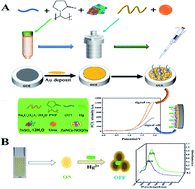A novel sensor for visual and selective detection of Hg2+ based on functionalized doped quantum dots†
Abstract
In this paper, a novel analytical platform for the visual, sensitive and reliable analysis of mercury ions (Hg2+) is fabricated based on functionalized doped quantum dots. We synthesized a new specific nano-material, zinc dithiothreitol combined with graphene quantum dots (ZnNCs–NGQDs), by a simple and convenient method which, as an efficient luminophore, was then applied to construct an electrochemiluminescence (ECL) system for the first time. Under optimized conditions, the ECL sensor showed an excellent response for Hg2+ in the linear range of 1.0 mM to 10 pM, with a low detection limit of 3 pM. Moreover, the proposed method demonstrated satisfactory selectivity, stability and acceptable reproducibility for the detection of Hg2+. The recovery of tap water and lake water samples ranged from 96% to 105%, indicating the potential applicability of the proposed method for monitoring environmental water samples. Meanwhile, visual attempts for mercury ion detection by using doped quantum dots have also obtained satisfactory results. Importantly, our research revealed a viable method for improving the sensitivity and convenience of target studies in sensing fields derived from functional material design.

- This article is part of the themed collection: Analytical Methods HOT Articles 2022


 Please wait while we load your content...
Please wait while we load your content...